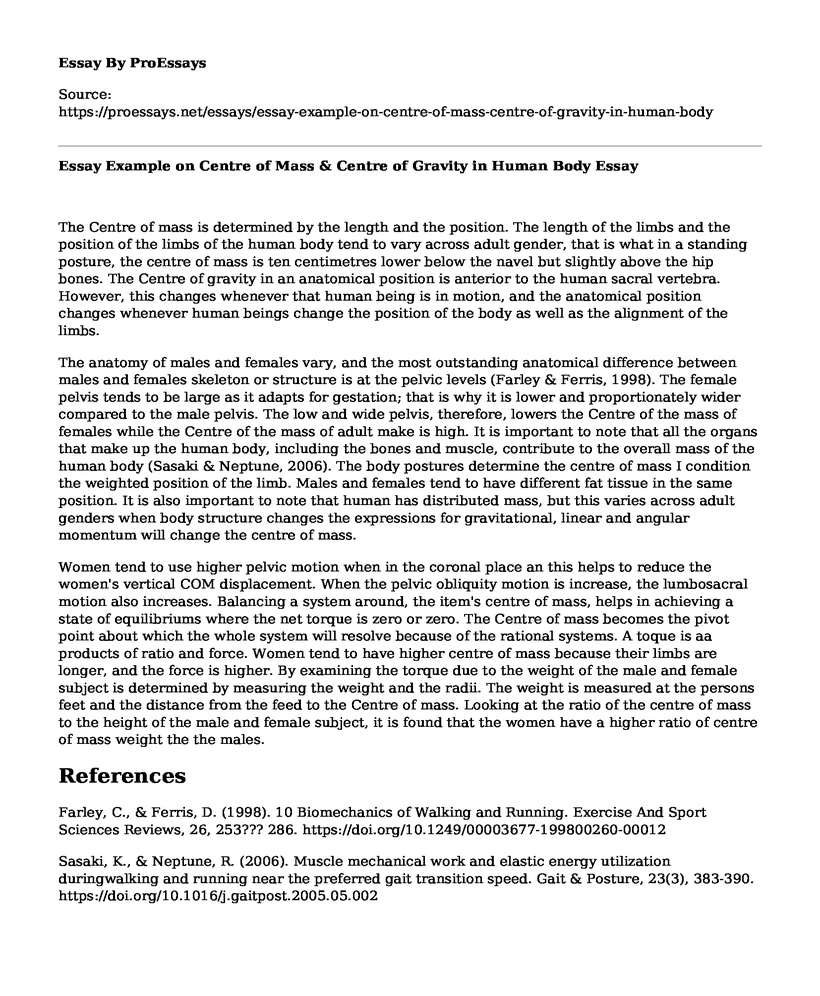The Centre of mass is determined by the length and the position. The length of the limbs and the position of the limbs of the human body tend to vary across adult gender, that is what in a standing posture, the centre of mass is ten centimetres lower below the navel but slightly above the hip bones. The Centre of gravity in an anatomical position is anterior to the human sacral vertebra. However, this changes whenever that human being is in motion, and the anatomical position changes whenever human beings change the position of the body as well as the alignment of the limbs.
The anatomy of males and females vary, and the most outstanding anatomical difference between males and females skeleton or structure is at the pelvic levels (Farley & Ferris, 1998). The female pelvis tends to be large as it adapts for gestation; that is why it is lower and proportionately wider compared to the male pelvis. The low and wide pelvis, therefore, lowers the Centre of the mass of females while the Centre of the mass of adult make is high. It is important to note that all the organs that make up the human body, including the bones and muscle, contribute to the overall mass of the human body (Sasaki & Neptune, 2006). The body postures determine the centre of mass I condition the weighted position of the limb. Males and females tend to have different fat tissue in the same position. It is also important to note that human has distributed mass, but this varies across adult genders when body structure changes the expressions for gravitational, linear and angular momentum will change the centre of mass.
Women tend to use higher pelvic motion when in the coronal place an this helps to reduce the women's vertical COM displacement. When the pelvic obliquity motion is increase, the lumbosacral motion also increases. Balancing a system around, the item's centre of mass, helps in achieving a state of equilibriums where the net torque is zero or zero. The Centre of mass becomes the pivot point about which the whole system will resolve because of the rational systems. A toque is aa products of ratio and force. Women tend to have higher centre of mass because their limbs are longer, and the force is higher. By examining the torque due to the weight of the male and female subject is determined by measuring the weight and the radii. The weight is measured at the persons feet and the distance from the feed to the Centre of mass. Looking at the ratio of the centre of mass to the height of the male and female subject, it is found that the women have a higher ratio of centre of mass weight the the males.
References
Farley, C., & Ferris, D. (1998). 10 Biomechanics of Walking and Running. Exercise And Sport Sciences Reviews, 26, 253??? 286. https://doi.org/10.1249/00003677-199800260-00012
Sasaki, K., & Neptune, R. (2006). Muscle mechanical work and elastic energy utilization duringwalking and running near the preferred gait transition speed. Gait & Posture, 23(3), 383-390. https://doi.org/10.1016/j.gaitpost.2005.05.002
Cite this page
Essay Example on Centre of Mass & Centre of Gravity in Human Body. (2023, May 30). Retrieved from https://proessays.net/essays/essay-example-on-centre-of-mass-centre-of-gravity-in-human-body
If you are the original author of this essay and no longer wish to have it published on the ProEssays website, please click below to request its removal:
- Khoisan of South Africa
- Postwar California
- Causes of Beach Erosion - Essay Example
- Research Paper Example: Skydiving and Science Advancement
- Paper Example on Physical and Chemical Weathering
- Oceanography Essay Example
- Pre-Service Teacher Mathematics: Enhancing Learning, Engagement & Knowledge - Essay Sample







